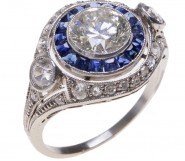Lot #12 - Sidney Nolan
-
Auction House:Deutscher and Hackett
-
Sale Name:The Gould Collection of Important Australian Art
-
Sale Date:15 Mar 2017 ~ 7pm
-
Lot #:12
-
Lot Description:Sidney Nolan
(1917 – 1992)
Leda And Swan, 1960
synthetic polymer paint on composition board
91.5 x 122.0 cm
signed with initial lower right: N; inscribed with title and date verso: LEDA + SWAN / 1960 / No … 59 / To NEWCASTLE 59 / FOLKSTONE
EXHIBITED: possibly: Sidney Nolan: Leda and the Swan and other recent work, Matthiesen Gallery, London, 16 June – 16 July 1960, cat. 27 – 29; Nolan, Hatton Gallery, University of Durham, Newcastle-upon-Tyne, then touring to: Graves Art Gallery, Sheffield; Temple Newsam House, Leeds; Ferens Art Gallery, Hull; City Art Gallery, Bristol; Walker Art Gallery, Liverpool; Scottish Royal Academy, Edinburgh; City Art Gallery, Wakefield, 13 May – 28 November 1961, cat. 59; Sidney Nolan: 1937 to 1979, Arts Centre, New Metropole, Folkstone, United Kingdom, 5 May – 3 June 1979, cat. 40 (illus. in exhibition catalogue); possibly: Sidney Nolan, Waddington Galleries, London, 1 – 25 February 1989 (label attached verso); The Director’s Choice 2015, Celebrating 35 Years, Gould Galleries, Melbourne, 1 May – 13 June 2015, cat. 13 (illus. in exhibition catalogue) -
Provenance:Estate of the artist, United Kingdom ; Thence by descent; Lady Mary Nolan, United Kingdom; Agnew’s, London, (label attached verso); Bonhams, Melbourne, 13 October 2014, lot 10; Gould collection, Melbourne
-
References:Nolan, exhibition catalogue, Kings College, University of Durham, Newcastle-Upon-Tyne, 1961, unpaginated, cat. 59 (illus.)
-
Notes:ESSAY: 1960 was a vibrant year for Australian artists in Britain with acclaimed exhibitions by Arthur Boyd, Albert Tucker and Sidney Nolan. Such was their presence that one critic advised ‘when in London ‘do as Melbourne does’ looks like becoming the keynote of the British art world this summer.’1 With the London opening in June of his extensive series based on the Greek myth of Leda and the Swan at Matthiesen Gallery, Nolan can truly be said to have arrived on the international scene. What made this even more remarkable was that it was the first time he had presented works based on a universal story rather than a purely Australian one. Financially, the show was an outstanding success and purchasers included Her Majesty Queen Elizabeth the Second, Sir Kenneth Clark (then Chairman of the Arts Council of Great Britain), the Earl of Drogheda (Chairman of both the Financial Times and the Royal Opera House, Covent Garden), Agatha Christie, and the Art Gallery of New South Wales. To have experienced the original Leda and Swan exhibition would have no doubt been akin to walking into a chapel filled with stained glass. Viewed as if through a watery veil, the chaste maiden Leda is in constant animation as she first rebuffs the swan’s advances (being the Greek god Zeus in disguise), then participates in a dangerous courtship dance before succumbing to his feathered charms. Sometimes the mood is calm, in others it is fierce, a battle of the wills; and the Leda and Swan on offer here 2 depicts the transformative conclusion in an image redolent with poetic synthesis. In a later interview Nolan observed that ‘in a way, Leda (is) the idea of a nude figure being overcome by some force or other … of Leda being overwhelmed by God.’3 In this Leda and Swan, Zeus is triumphant yet gentle, hovering over Leda with his outstretched neck curving to embrace his relaxed, expectant companion. Nolan had been experimenting for the previous eighteen months with the recently-developed polyvinyl acetate applied with squeegees, fingers and brush. His fluid handling of this cutting-edge material in the Leda paintings enhanced the perception that his figures were swimming within the paint, sometimes above, often through, the viscid surface, flowing in and out of visibility. In a famed quote from one of her books, Cynthia Nolan recorded the process: ‘During the day he painted on the floor, first placing areas of colour on prepared board, next sweeping on polyvinyl acetate until the whole 4 x 5 feet area was thick with paint, then seizing a short-handled squeegee and slashing and wiping, cornering and circling like a skater, until another painting was completed … Now over and over again, he was painting Leda and the Swan.’4 In this current painting, Nolan’s painterly technique is on full show with drips seeping through the swan’s neck and scraped areas giving the wings a sensation of blurred flight. Even when separated from its companions, this Leda and Swan remains an image of complete harmony and unification, and its own unique statement. 1. Stephen May, 2000, quoted in: Burke, J., Australian Gothic: a life of Albert Tucker, Knopf, Sydney, 2002, p. 361 2. All paintings in the series bear the same title. 3. Nolan, S., quoted in: Souter, G., ‘An artist who stood in the acid’, Sydney Morning Herald, Sydney, 7 October 1967 4. Nolan, C., Open Negative: an American memoir, Macmillan, London, 1967, p. 224 ANDREW GAYNOR
-
Estimate:A$50,000 - 70,000
-
Realised Price:
-
Category:Art
This Sale has been held and this item is no longer available. Details are provided for information purposes only.










